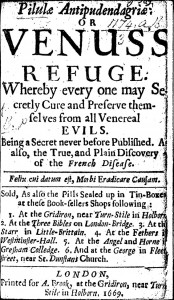Since the late 1990s direct-to-consumer (DTC) pharmaceutical marketing has become a standard part of society in the U.S. (perhaps also in Australia, where DTC advertising is also legal). Ads in magazines and newspapers, on the internet, TV, or the radio promise that taking some wonder drug will alleviate your suffering from any number of symptoms (often at the risk of some possibly life-threatening side effects). Pfizer, Bayer, Lilly and others did not invent DTC marketing. They are following the footsteps of their esteemed predecessors, 19th-century patent medicine companies who turned an earlier practice into a multi-million dollar industry. In the 1670s and 1680s practitioners of all sorts promised to have a cure for the scurvy epidemic in England.
Toward the beginning of the scurvy epidemic, P.B. published his Pilulae antipudendagriae (1669) describing the French Disease, its symptoms, and his wonder drug.

More than just a cure for the French Disease, P.B. promised that his pilulae antipudendagriae would cure a host of “venereal evils.” Twelve years of experience in Europe and India had proven the effectiveness of his medicines in curing:
The French Disease, and virulent running of the reins [gonorrhea] (which is one and the same disease, as is declared in the Chapter on Signes of the French Disease) but also of all diseases arising from Putrefaction, Fermentation, or Obstruction (if curable) as the Scurvy, Green-sickness, all diseases of Wormes which proceed of Putrefaction. All Itches, which arise by Firmentation of Humours and such like, &c.
After surveying various explanations for the advent of the French Disease, P.B. claims the Spanish brought it back from the West Indies. Rather than find some occult cause or source, P.B. claims it arose from the fermentation of a corrupt seed in “the womb of a most Diabolical American.” Here is the standard Columbian Theory Having sex with an infected woman or
immediately succeed them on a Close-Stool or suck, or sucle or any ways happen to communicate of any contagious pollutions from them.
P.B. reviews the key symptoms of the French Disease in both men and women: fevers, pains in the limbs, burning sensation while urinating, swellings, ulcers. It’s a checklist sufficiently broad to describe most people at some point. He assured readers that if they took his pills, three or four a day, they would be cured of their suffering. Each box of pilulae cost 5 shillings, rather more than the scurvy remedies a couple years later.
He apologizes for not including testimony from satisfied, presumably cured, customers. He explains that customers are understandably embarrassed to admit to having had the French Disease. Curious readers are encouraged to contact P.B. directly for such testimony.
While it’s easy to see all the pieces of standard DTC marketing—a socially stigmatized disease, a checklist of symptoms, a description of its cause and transmission, testimony, and a pill—it also interesting to look back even earlier and compare P.D.’s Pilulae Antipudendagriae to the plague pamphlets that circulated in large numbers from the middle of the 14th century right through the 17th century. Whereas plague pamphlets often included some features, P.B.’s pamphlet as well as those of his contemporaries added testimonies and served to market a particular remedy. P.B. was selling his Pilulae Antipudendagriae to cure he French Disease; a few years later, an anonymous pamphlet was marketing Pilulae Antiscrobuticæ to cure scurvy. Within a decade dozens of pamphlets were advertising various proprietary medicines guaranteed to cure the ailment du jour.
One reply on “Pilulae Antipudendagriae—More Early DTC Marketing”
[…] a rapid development of a patent medicine market. See, for example, the scurvy epidemic or the Pilulae Antipudendagriae or the widespread marketing use of the […]